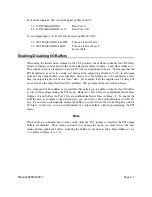
PCI-DIO48(S)(S) Manual
Page 2-4
Manual 00650-529-1
Findbase.exe
DOS utility to determine an available base address for ISA bus , non-Plug-n-Play cards. Run this
program once, before the hardware is installed in the computer, to determine an available address
to give the card. Once the address has been determined, run the setup program provided with the
hardware to see instructions on setting the address switch and various option selections.
Poly.exe
A generic utility to convert a table of data into an nth order polynomial. Useful for calculating
linearization polynomial coefficients for thermocouples and other non-linear sensors.
Risc.bat
A batch file demonstrating the command line parameters of RISCTerm.exe.
RISCTerm.exe
A dumb-terminal type communication program designed for RS422/485 operation. Used primarily
with Remote Data Acquisition Pods and our RS422/485 serial communication product line. Can
be used to say hello to an installed modem. RISCTerm stands for Really Incredibly Simple
Communications TERMinal.
Installing the Card
The PCI-DIO48(S)(S) card can be installed in a five-volt PCI slot of an IBM or compatible
computer. Before installing the card, carefully read the Option Selection section of this manual
and configure the card according to your requirements. Finally, our SETUP.EXE program will
lead you through the process of setting the options on the PCI-DIO48(S)(S). The setup program
does not set the options. These must be set manually by jumpers on the card.
To Install the Card
1.
Turn OFF computer power.
2.
Remove the computer cover.
3.
Install jumpers from either Chapter 3, Option Selection of this manual or the suggestions
of our SETUP.EXE software program.
4.
Loosen the nuts on the strain relief bar and swing the top end free.
5.
Install the card in an available PCI-bus slot. You may need to remove a backplate first.
6.
Thread the I/O cables, one at a time, through the cutout in the mounting bracket and plug
them into the headers on the card. Port 0 is the one closest to the mounting bracket.
7.
Smooth the cables as close as practicable to the card and, while holding them close to the
card surface, swing the strain relief bar into position and tighten the nuts.
8.
Inspect for proper fit of the card and tighten screws. Make sure that the card mounting
bracket is properly screwed into place and that there is a positive chassis ground.
9.
Replace the computer cover and turn the computer ON.
10.
Enter the CMOS setup program of your system and verify that the PCI plug-and-play
option is set appropriately for your system. Systems running Windows95 (or any other
PNP-compliant Operating System) should set the CMOS option to OS. Systems running
under DOS, WindowsNT 3.51, Windows 3.1, or any other non-PNP-compliant Operating






























